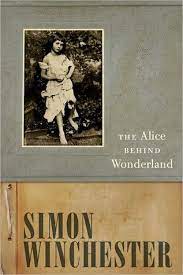The Alice Behind Wonderland
This book, The Alice Behind Wonderland, by Simon Winchester, 2011, is claimed to be about the girl who inspired Charles Dodgson (pen name Lewis Carroll) to write Alice's Adventures in Wonderland.
However, the title is misleading – there isn’t much about Alice Liddell except for basic facts about her life. Most of the book focuses on Dodgson’s photography, with background information about the development and state of photography at the time. By the end of the book (only 110 pages with index) I didn’t really know what it was about. There were too many “tidbits” given about the Liddell family, Dodgson’s work, his photography, and descriptions of photos that the reader doesn’t see. But there is no connection among them – they read like a list.
I
had read Simon Winchester’s book, The
Surgeon of Crowthorne (see my post of March 17, 2021), also known as The Professor and the Madman in the USA
and Canada, and liked his writing style and attention to detail. But the
information and structure of this book is disjointed, sometimes repetitive, and
didn’t have much focus.
The
first chapter, “The Photograph in Question” (Alice as Beggar Girl, see book cover, above left) gives information about how the photograph
was acquired by the collections it ended up in and describes it in detail. But
it is not really covered any more in the book. And it’s not clear how this
relates to the “Alice behind Wonderland.” One of the reasons this photo is
significant is that Alice’s pose and expression are rather suggestive – but of
what? Winchester never goes into detail about the different reactions to and
interpretations of the photo.
And
for a book that is mostly about Dodgson’s photography, there are no photos in the
book (except the cover photo that is also on a page before the copyright). With
some of the photos, Winchester speculates about what the subject was thinking
at the time, which I found rather annoying without any background information
or support.
For
example, in describing a photo that Dodgson took of Alice when she was 18 (his
last photo of her), he writes:
“She
is facing to her right – forward to her future, if we assume the same
convention here as the photographer had adopted in the Southey-and-skeleton
pictures. And yet her face wears a tragic look of such ineluctable sadness that
the viewer has to wonder: What on earth
is wrong? Does life’s prospect hold no comfort or pleasant mystery? Is it
really all a torment? Or is it all a joke, a charade? Did perhaps the now
thirty-eight-year-old Reverend Dodgson, a man who, after all, would have to
abandon his studentship at the college, and thus his entire academic career, if
ever he dared to seek your hand, did he ask you to act out an artificial
misery, to suggest to the world an image of hopelessness – merely to underline
for all to see his own pain at losing you to the great outside?”
I
searched for the photo on the internet, and think this is the one Winchester is
writing about:
She
certainly doesn’t look very happy, but I wouldn’t consider it “a tragic look of
such ineluctable sadness.” And his speculation about her thoughts or Dodgson’s
purpose seems over the top.
He
engages in this kind of speculation again in the scrap of information about
Alice’s later life. Winchester quotes “her biographer” (who is not identified):
”’However
much she laughed and sang,’ wrote her biographer, ‘however much she indulged
that insatiable curiosity, the sadness was somehow always there.’"
Winchester continues, “She
missed something, and we all may like to imagine precisely what that something
was: long-ago golden Oxford summer afternoons, that time of delicious
foolishness, when Charles Dodgson would come a-calling and would take the
photographs, and organize the picnics and the expeditions, and would tell the
girls – and to her most devotedly – the most fantastic stories. A glittering
society life and a thousand Hampshire balls could somehow never quite compete.”
Now,
come on! I certainly would not like to imagine any such thing.
With
all the negative aspects of this book, perhaps it is quibbling to add a few
stylistic points. Alice named her younger son ‘Caryl,’ which Winchester writes
is a “version of the first name of the author of Alice’s Adventures,” although
it is the last name of his pen name. And throughout the book he uses Latin or French phrases
that I felt were not necessary (eg., “I happily used his book as vade mecum …”).
I’m not really sure why Winchester wrote this book. It doesn’t give a lot of information about Alice, Dodgson, the photographs or any other topic he includes. He could have written a more interesting and coherent book with more research and better editing.

Comments
Post a Comment